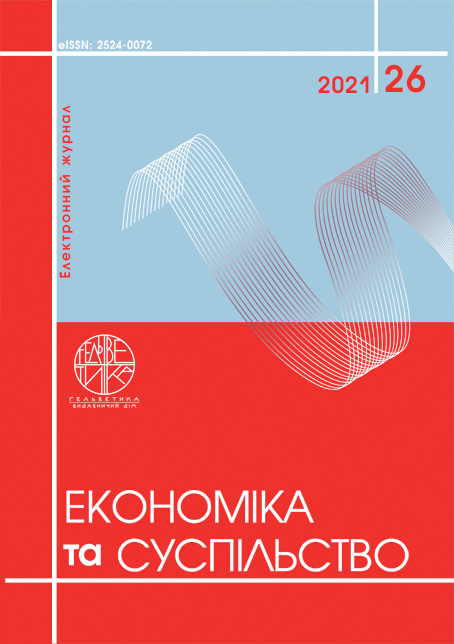FORMATION OF HR-BRAND OF THE COMPANY AND ITS EVALUATION
Abstract
In times of various economic transformations and trials, every enterprise must have certain assets that would ensure economic growth. Under such conditions, the company's brand as an employer can be considered an excellent and necessary asset. Because a successful HR-brand, both internal and external, will help attract and retain the best professionals in the industry in which the company operates. The article analyzes the methodology of employer brand formation. In particular, the key models of employer brand formation are listed. The model that, according to the authors, is the most effective in the formation of a successful HR-brand is identified and analyzed. The analysis of the HR-brand of PrJSC "Obolon" was carried out according to different methods to obtain objective results. The level of staff involvement as a direct indicator of the state of the company's hr-brand was studied using the Q12 questionnaire developed by the American Institute for Public Opinion Research. Based on the complex author's method of S. Mokina at the points of contact, a general assessment was made and the internal and external brand of the employer was studied in detail. The index of strength of the employer's brand is calculated and the diagram and matrix of the employer's brand are constructed. The employer brand strength diagram provides a clear demonstration of the gap between the employer's external and internal brand, at each point of contact, and identifies areas that need intervention to reduce this gap and increase brand effectiveness. Thus, the Obolon HR-brand has a strong internal hr-brand, but a weak external one. The level of involvement and loyalty to the employer is at a good level, and work in the company is a positive experience, according to employees, at their points of contact with the employer. However, the external hr-brand shows that although the company is known in the labor market, but its image as an employer is negative rather than positive at certain points of contact, reviewing and making appropriate management decisions can change the current situation. The obtained results can be used in the theory and practice of forming the HR-brand of the company.
References
Васьків Р.І. Місце бренду роботодавця в загальному брендингу компанії. Науковий вісник НЛТУ України. 2014. № 24(6). С. 169–175.
Залученість персоналу: Gallup Q12. URL: https://hurma.work/blog/zaluchenist-personalu-gallup-q12-spisok-pitan/ (дата звернення: 30.04.2021)
Лозовський О.М. HR-брендинг: формування іміджу підприємства. Економіка та управління підприємствами. 2020. № 43. С. 201–205.
Мокіна С.М. Концепція бренду роботодавця: сутність, функції, класифікація, інструменти формування. Вісник Хмельницького національного університету. 2014. № 6, Т. 1. С. 189–196.
Мокіна С.М. Моделі формування бренда роботодавця. Бізнесінформ. 2014. № 7. С. 389–398.
Мокіна С.М. Методика оцінювання сили бренду роботодавця за точками контакту. Інноваційна економіка. 2014. №1. С. 132–145.
Писаревська Г.І., Аграмакова Н.В., Семенченко А.В., HR-брендинг як складова бізнес стратегії підприємства. Економічні науки. 2019. № 33. С. 176–180.
Синиця С.М., Вакун О.В., Фурса Т.П. Особливості формування іміджу підприємства як чинник конкурентоспроможності на зовнішніх ринках. Економіка та управління підприємствами. 2019. № 38(1). С. 147–151.
Vaskiv R.I. (2014). Mistse brendu robotodavtsya v zahal'nomu brendynhu kompaniyi [The place of the employer's brand in the overall branding of the company]. Scientific Bulletin of NLTU of Ukraine. №24 (6), pp. 169–175.
Zaluchenist personalu: Gallup Q12 [Staff involvement: Gallup Q12]. Available at: https://hurma.work/blog/zaluchenist-personalu-gallup-q12-spisok-pitan/ (accessed: 30.04.2021)
Lozovskyy O.M. (2020). HR-brendynh: formuvannya imidzhu pidpryyemstva [HR-branding: the formation of the image of the enterprise. Economics and business management]. Ekonomika ta upravlinnia pidpryiemstvamy, №43, pp. 201–205
Mokina S.M. (2014). Kontseptsiya brendu robotodavtsya: sutnist', funktsiyi, klasyfikatsiya, instrumenty formuvannya [The concept of the employer's brand: the essence, functions, classification, tools of formation]. Bulletin of Khmelnytsky National University. № 6, T. 1, pp. 189–196.
Mokina S.M. (2014). Modeli formuvannya brenda robotodavtsya [Models of employer brand formation]. Busines-sinform, № 7, pp. 389–398.
Mokina S.M. (2014). Metodyka otsinyuvannya syly brendu robotodavtsya za tochkamy kontaktu [Methods for assessing the strength of the employer's brand by points of contact]. Innovative economy, №1, pp. 132–145.
Pisarevska G.I. (2019) HR-brendynh yak skladova biznes stratehiyi pidpryyemstva [Agramakova NV, Semenchenko AV, HR-branding as a component of business strategy of the enterprise]. Economic sciences, № 33, pp. 176–180.
Sinitsa S.M., Vakun O.V., Fursa T.P. (2019).Osoblyvosti formuvannya imidzhu pidpryyemstva yak chynnyk konkurentospromozhnosti na zovnishnikh rynkakh [Features of enterprise image formation as a factor of competitiveness in foreign markets]. Economics and business management, №38 (1), pp. 147–151.


